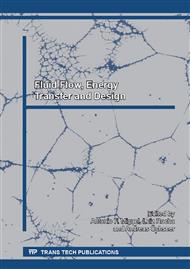[1]
V.I. Terekhov, S.V. Kalinina, V.V. Lemanov, The mechanism of heat transfer in nanofluids: state-of-the-art problem. Part 2. Convective heat exchange, Thermophysics & Aeromechanics (2010) 173-188.
DOI: 10.1134/s0869864310020010
Google Scholar
[2]
B. Pak, Y.I. Cho, Hydrodynamic and heat transfer study of dispersed fluids with submicron metallic oxide particle, Experimental heat transfer 11 (1998) 151–170.
DOI: 10.1080/08916159808946559
Google Scholar
[3]
K.S. Hwang, J.H. Lee, S.P. Jang, Buoyancy-driven heat transfer of water-based Al2O3 nanofluids in a rectangular cavity, Int. J. of heat and mass transfer 50 (2007) 4003–4010.
DOI: 10.1016/j.ijheatmasstransfer.2007.01.037
Google Scholar
[4]
V. Ya. Rudyak, A.A. Belkin, Modelling of the transport coefficients of nanofluids, Nanosystems: physics, chemistry, mathematics (2010) 156-177.
Google Scholar
[5]
J. Вuongiorno, Convective transport in nanofluids, Transactions of ASME 128 (2006) 240-250.
Google Scholar
[6]
V. Ya. Rudyak, A.V. Minakov, A.A. Gavrilov, A.A. Dekterev, Application of new numerical algorithm of solving the Navier–Stokes equations for modeling the work of a viscometer of the physical pendulum type, Thermophysics & Aeromechanics (2008).
DOI: 10.1134/s0869864308020169
Google Scholar
[7]
V. Ya. Rudyak, A.V. Minakov, A.A. Gavrilov, A.A. Dekterev, Simulation of flows in micromixers, Thermophysics & Aeromechanics (2010) 565-576.
DOI: 10.1134/s0869864310040098
Google Scholar
[8]
A.V. Minakov, V. Ya. Rudyak, A.A. Gavrilov, A.A. Dekterev, Mixing in T-shaped micromixer at average Reynolds number, Thermophysics & Aeromechanics (2012) 577-587.
DOI: 10.1134/s0869864312030043
Google Scholar
[9]
A.V. Gavrilov, A.V. Minakov, A.A. Dekterev, V. Ya. Rudyak, Numerical algorithm for simulating laminar flows in an annular channel with eccentricity, Sib. J. Industr. Matem. 13 4 (2010) 3-14.
DOI: 10.1134/s1990478911040119
Google Scholar
[10]
C.J. Ho, W.K. Liu, Y.S. Chang, C.C. Lin, Natural convection heat transfer of alumina-water nanofluid in vertical square enclosures: an experimental study, Int. J. Therm. Sci. (2010) 1345-1353.
DOI: 10.1016/j.ijthermalsci.2010.02.013
Google Scholar
[11]
S.Q. Zhou, R. Ni, Measurement of the specific heat capacity of water-based Al2O3 nanofluid, Appl. Phys. Lett. (2008) 93-123.
Google Scholar
[12]
S.E.B. Maiga, C.T. Nguyen, N. Galanis, G. Roy, Heat transfer behaviours of nanofluids in a uniformly heated tube, Superlatt. Microstruct. (2004) 543-557.
DOI: 10.1016/j.spmi.2003.09.012
Google Scholar
[13]
C.T. Nguyen, F. Desgranges, G. Roy, N. Galanis, T. Mar´e, S. Boucher, H.A. Mintsa, Temperature and particle-size dependent viscosity data for water-based nanofluids – hysteresis phenomenon, Int. J. Heat Fluid Flow (2007) 1492-1506.
DOI: 10.1016/j.ijheatfluidflow.2007.02.004
Google Scholar
[14]
S.M.S. Murshed, K.C. Leong, C. Yang, Investigations of thermal conductivity and viscosity of nanofluids, Int. J. Therm. Sci. (2008) 560-568.
DOI: 10.1016/j.ijthermalsci.2007.05.004
Google Scholar
[15]
K.B. Anoop, S. Kabelac, T. Sundararajan, S.K. Das, Rheological and flow characteristics of nanofluids: influence of electroviscous effects and particle agglomeration, J. Appl. Phys. 106 (2009) 034909.
DOI: 10.1063/1.3182807
Google Scholar
[16]
H. Chen, Y. Ding, Y. He, Ch. Tan, Rheological behavior of ethylene glycol based titania nanofluids, Chem. Phys. Lett. (2007) 333–337.
DOI: 10.1016/j.cplett.2007.07.046
Google Scholar
[17]
W. Yu, S.U.S. Choi, The role of international layers in the enhanced thermal conductivity of nanofluids: a renovated Maxwell model, Journal on Nanoparticle Research (2003) 167-171.
DOI: 10.1023/a:1024438603801
Google Scholar
[18]
H.A. Minsta, G. Roy, C.T. Nguyen, D. Doucet, New temperature dependent thermal conductivity data for water-based nanofluids, Int. J. Therm. Sci. (2009) 363-371.
DOI: 10.1016/j.ijthermalsci.2008.03.009
Google Scholar
[19]
S. Lee, S.U.S. Choi, S. Li, J.A. Eastman, Measuring thermal conductivity of fluids containing oxide nanoparticles, ASME J. Heat Transfer (1999) 280-289.
DOI: 10.1115/1.2825978
Google Scholar
[20]
G. Roy, C.T. Nguyen, P. -R. Lajoie, Numerical investigation of laminar flow and heat transfer in a radial flow cooling system with the use of nanofluids, Superlatt. Microstruct. (2004) 497-511.
DOI: 10.1016/j.spmi.2003.09.011
Google Scholar
[21]
S.K. Das, N. Putra, P. Thiesen, W. Roetzel, Temperature dependence of thermal conductivity enhancement for nanofluids, J. Heat Transfer (2003) 567-574.
DOI: 10.1115/1.1571080
Google Scholar
[22]
K.B. Anoop, T. Sundararajan, S.K. Das, Effect of particle size on the convective heat transfer in nanofluid in the developing region, Int. J. of Heat and Mass Trans. (2009) 2189-2195.
DOI: 10.1016/j.ijheatmasstransfer.2007.11.063
Google Scholar
[23]
W. Y. Lai, S. Vinod, P. E. Phelan, R. Prasher, Convective Heat Transfer for Water-Based Alumina Nanofluids in a Single 1. 02-mm Tube, Journal of heat transfer 131 (2009) 112401.
DOI: 10.1115/1.3133886
Google Scholar
[24]
B. Kolade, E. Goodson, J.K. Eaton, Convective performance of nanofluids in a laminar thermally developing tube flow, Journal of heat transfer 131 (2009) 052402.
DOI: 10.1115/1.3013831
Google Scholar
[25]
D. Liu, L. Yu, Single-phase thermal transport of nanofluids in a minichannel, Journal of heat transfer, 133 (2011) 031009.
Google Scholar
[26]
A.S. Lobasov, A.V. Minakov, Computer modelling of heat and mass transfer processes in microchannels using CFD-package SigmaFlow, Computer research and modeling (2012) 781-793.
DOI: 10.20537/2076-7633-2012-4-4-781-792
Google Scholar
[27]
A.S. Lobasov, A.V. Minakov, A.A. Dekterev, Simulation of fluid flow and convective heat transfer in microchannels, Comp. continuum mechanics (2012) 481-488.
Google Scholar
[28]
F.R. Menter, Zonal two equation k-w turbulence models for aerodynamic flows / AIAA Paper № 93-2906 (1993).
Google Scholar
[29]
M.S. Lobasova, A.S. Lobasov, Convective heat exchange in a single-phase medium: teaching manual, Siberian Federal University, Krasnoyarsk, (2012).
Google Scholar


